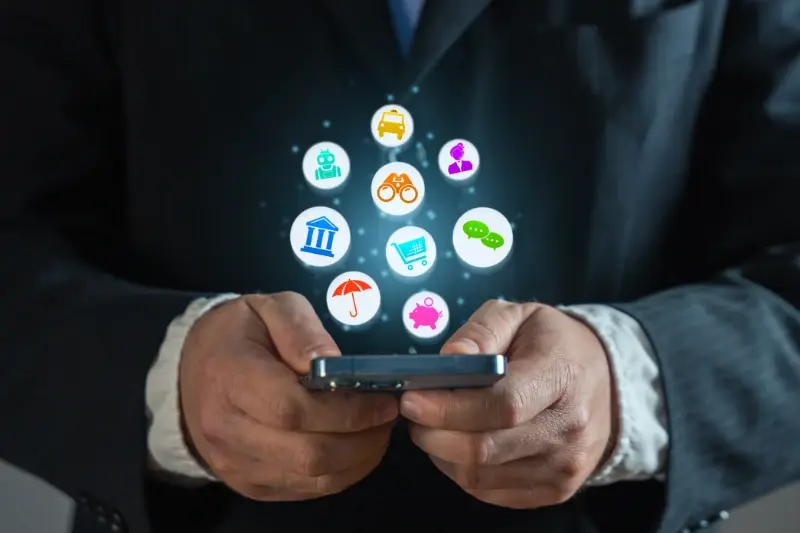10 Ways Machine Learning Can Actually Help Your Business App
Over 90% of business apps fail to reach their full potential because they're built like digital brochures rather than intelligent tools. I've seen this pattern repeat itself countless times—companies spend thousands building beautiful apps that look great but don't actually solve real problems or adapt to how people use them.
Machine learning changes this completely. It's not just a buzzword that tech companies throw around to sound clever; it's a practical way to make your business app work harder for both you and your users. Think of it as giving your app a brain that learns from every interaction, gets better over time, and starts predicting what people need before they even ask for it.
The best business apps don't just store information—they turn that information into insights that drive real business value
What makes machine learning so powerful for business apps is that it solves the personalisation problem. Every user is different, every business has unique needs, and one-size-fits-all solutions rarely work well for anyone. Machine learning lets your app adapt to these differences automatically, creating experiences that feel tailored without requiring you to manually configure everything. From streamlining customer support to spotting security threats before they become problems, AI benefits extend far beyond what most people realise. Your business app can become a competitive advantage rather than just another expense on the books.
Machine Learning Makes Your App Smarter for Users
Machine learning sounds complicated, but really it's just a way for computers to learn from information and get better at helping people. Think of it like teaching your app to become smarter every time someone uses it—which is pretty cool when you think about it!
When we build apps with machine learning, they start to understand what users actually want before they even ask for it. Your app begins to notice patterns: maybe people always check their messages first thing in the morning, or they tend to order the same type of food on Fridays. The app learns these habits and starts making helpful suggestions.
Learning from Every Interaction
Every tap, swipe, and search teaches the app something new about how people behave. This means the app gets better at predicting what someone might want to do next. If someone always opens the camera feature after checking their notifications, the app might start showing a quick camera shortcut right there on the main screen.
Adapting to Individual Needs
The really clever bit is that machine learning doesn't treat everyone the same way. It recognises that different people use apps differently—some people are fast clickers who want everything immediately, whilst others prefer to take their time and browse. The app adjusts its behaviour accordingly, making the experience feel natural for each person.
This isn't about collecting personal information or being intrusive; it's about making the app work better for everyone who uses it. When an app understands how people prefer to navigate and what they're trying to accomplish, it can remove unnecessary steps and show the right features at the right time.
Personalised Experiences That Keep People Coming Back
When I look at the most successful business apps today, they all share one thing in common—they know their users really well. Machine learning makes this possible by watching how people use your app and learning what they like. It's not creepy surveillance; it's smart observation that helps you serve each person better.
Think about it this way: if someone always checks their sales reports first thing Monday morning, your app can learn this pattern and have those reports ready to go. If another user prefers pie charts over bar graphs, the app remembers and shows data the way they like it best. This isn't magic—it's machine learning algorithms working behind the scenes to create a better experience for everyone.
Start small with personalisation. Pick one feature—like dashboard layout or notification timing—and let machine learning optimise it based on user behaviour patterns.
What Machine Learning Can Personalise in Your Business App
- Dashboard layouts and which widgets users see first
- Notification timing and frequency based on when people actually engage
- Content recommendations for reports, articles, or tools
- Interface preferences like colour schemes or menu arrangements
- Feature suggestions based on what similar users find helpful
The AI benefits here are massive for user retention. When your business app feels like it was built just for them, people stick around longer. They're more likely to recommend it to colleagues too. Machine learning helps you move beyond one-size-fits-all solutions to create something that genuinely feels personal and useful for each individual user.
Better Search and Discovery Features
Search functions in apps used to be pretty basic—you'd type something in and hope for the best. Machine learning has completely changed this game by making search much smarter and more helpful for your users.
When someone searches in your app, machine learning algorithms can understand what they actually mean, not just the exact words they typed. If a user searches for "red jumper" but you only have "crimson sweaters" in your inventory, smart search will still show them relevant results. The system learns from thousands of previous searches to understand synonyms, common spelling mistakes, and different ways people describe the same thing.
How Machine Learning Improves App Discovery
The real magic happens with discovery features—helping users find things they didn't even know they were looking for. Machine learning analyses user behaviour patterns, purchase history, and browsing habits to surface content that's genuinely relevant. This isn't just showing popular items; it's about understanding individual preferences and matching them with available options.
- Autocomplete suggestions that get better over time
- Visual search capabilities using image recognition
- Trending searches based on real user data
- Smart filtering that adapts to user preferences
- Category recommendations that make sense
The technology also learns from collective user behaviour. If people who search for coffee makers also tend to look at kitchen scales, the system starts suggesting related items. This creates a more natural browsing experience that feels less like a computer algorithm and more like getting recommendations from someone who knows what you like.
What makes this particularly powerful for business apps is that better search means users find what they want faster, spend more time in your app, and are more likely to complete purchases or actions.
Smart Predictions Help Users Make Decisions
Making decisions can be hard work—and that's where smart predictions in your business app can really make a difference. Machine learning algorithms can look at patterns in user behaviour, past purchases, and even external data to suggest what someone might want or need next. It's like having a helpful assistant that remembers everything and spots patterns we might miss.
Think about how streaming services suggest what to watch next, or how shopping apps recommend products. Your business app can do something similar, but tailored to whatever service you provide. If you run a food delivery app, it might predict that someone usually orders pizza on Friday evenings. A fitness app could suggest workout routines based on previous activity levels and goals.
Making Complex Choices Simple
The real magic happens when your app helps users make complicated decisions. Financial apps can predict spending patterns and warn users before they overspend. Project management apps can estimate how long tasks will take based on similar past projects. Medical apps can flag potential health risks by spotting unusual patterns in user data.
Smart predictions turn overwhelming choices into simple, personalised recommendations that users can trust
What makes these predictions truly valuable is accuracy. Machine learning gets better over time—the more data it processes, the smarter it becomes. This means your business app doesn't just help users make decisions; it learns their preferences and gets better at helping them. Users start to rely on these suggestions because they're genuinely useful, which keeps them coming back to your app instead of trying alternatives.
Automated Customer Support That Actually Works
Customer support through apps has traditionally been rubbish, hasn't it? You tap the help button and get stuck in endless loops of unhelpful FAQs or wait ages for a human to respond. Machine learning is changing this completely by creating support systems that can actually solve problems rather than just pretend to help.
Smart chatbots powered by machine learning can understand what users are really asking for—not just match keywords like the old systems did. They learn from thousands of previous conversations and get better at providing useful answers over time. When someone asks "my payment didn't work", the bot understands they need transaction help, not just a generic response about payments.
Learning from Real Conversations
The best part about machine learning in customer support is that it learns from real user interactions. Every conversation makes the system smarter; it starts recognising patterns in how people describe problems and what solutions actually work. This means fewer frustrated users and less work for your human support team.
Knowing When Humans Are Needed
Machine learning also knows when to step aside. Complex issues, emotional situations, or problems the system hasn't seen before get passed straight to human agents—along with all the context from the conversation so far. Users don't have to repeat themselves, and support agents can focus on solving real problems instead of answering basic questions about password resets.
The result is support that feels more personal and helpful whilst reducing costs. Users get quick answers to simple questions and proper human attention when they need it most.
Data Security and Fraud Detection
Here's something that keeps business owners awake: protecting their users' data and money. Machine learning has become one of the most effective ways to spot fraudulent activity and security threats before they cause real damage to your business app users.
Traditional security systems work by checking against known patterns of bad behaviour. But criminals are clever—they constantly change their tactics. Machine learning systems learn from every single transaction, login attempt, and user action. They build up a picture of what normal behaviour looks like for each user, then flag anything that seems off.
How ML Spots the Bad Guys
Your machine learning system might notice that someone usually logs in from London between 9am and 6pm, then suddenly there's a login attempt from another country at 3am. Or it might spot that a payment pattern doesn't match someone's usual spending habits. The system doesn't just block these activities outright—it can ask for extra verification or temporarily limit account access whilst you investigate.
Start with basic fraud detection rules first, then layer machine learning on top. This gives you immediate protection whilst your ML system learns your users' patterns.
Different Types of Protection
- Login anomaly detection spots unusual access patterns
- Transaction monitoring catches suspicious payment behaviour
- Device fingerprinting identifies compromised phones or tablets
- Behaviour analysis notices when someone's app usage suddenly changes
- Network analysis detects coordinated attacks from multiple accounts
The best part? These systems get smarter over time. Each false alarm teaches them to be more accurate, and each real threat they catch helps them spot similar problems faster in the future.
Voice and Image Recognition Capabilities
Voice and image recognition are two of the most practical ways machine learning can transform how people interact with your business app. Gone are the days when typing was the only way to communicate with an app—now users can simply speak or show their phone a picture to get what they need.
Voice recognition lets users control your app hands-free, which is particularly useful when they're driving, cooking, or carrying shopping bags. Banking apps use voice commands for balance enquiries; fitness apps let users log workouts by speaking; shopping apps allow voice searches for products. The technology has become remarkably accurate—it can handle different accents, background noise, and even whispered commands.
How Image Recognition Opens New Possibilities
Image recognition might be even more impressive in terms of what it can do for your business. Users can point their camera at objects and get instant information or actions. Retail apps identify products for quick purchasing; food delivery apps scan restaurant menus; banking apps process cheque deposits through photos; travel apps translate foreign text in real-time.
The machine learning models behind these features get smarter with every interaction. They learn to recognise new objects, understand context better, and work in challenging conditions like poor lighting or unusual angles.
Simple Integration Options
The best part? You don't need to build these capabilities from scratch. Here are the main ways to add voice and image recognition:
- Use existing APIs from Google, Amazon, or Microsoft for quick implementation
- Integrate with device-native features like Siri or Google Assistant
- Build custom models for industry-specific recognition needs
- Combine multiple recognition types for more sophisticated interactions
These features work particularly well when they solve genuine problems rather than just showing off technology—users will adopt them quickly when they make tasks genuinely easier.
Conclusion
Look, I'll be straight with you—machine learning isn't some magic wand that will instantly transform your business app into the next big thing. But what it can do is make your app work harder for both you and your users, and that's where the real value lies.
We've covered quite a bit of ground here, from personalised experiences that keep users engaged to smart security features that protect their data. Each of these machine learning applications serves a purpose—they solve real problems that businesses face every day. Whether it's reducing the load on your customer support team through intelligent chatbots or helping users find exactly what they're looking for with better search functionality, these aren't just trendy tech features. They're practical tools that can genuinely improve how your app performs.
The beauty of machine learning in business apps is that it gets better over time. The more people use your app, the smarter it becomes—and the more valuable it becomes to your users. That's the kind of competitive advantage that's worth investing in.
Now, you don't need to implement every single one of these features right away. Start with what makes sense for your business and your users. Maybe that's predictive features that help with decision-making, or perhaps automated support is your biggest pain point. The key is choosing the AI benefits that align with your business goals and actually solve problems your users care about. If you're wondering how much it costs to add AI features or whether you can add machine learning to your existing app, remember that you have options that don't require hiring a team of AI experts to get started. After all, the best business app is one that people want to keep using.
Share this
Subscribe To Our Blog
You May Also Like
These Related Stories

The Business Owner's Guide to Voice Technology in Mobile Apps

The Real ROI of Mobile Apps for Different Business Types





